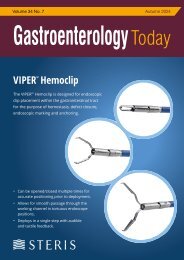Gastroenterology Today Winter 2023
Gastroenterology Today Winter 2023
Gastroenterology Today Winter 2023
Create successful ePaper yourself
Turn your PDF publications into a flip-book with our unique Google optimized e-Paper software.
FEATURE<br />
FEATURE<br />
GASTROENTEROLOGY TODAY – WINTER <strong>2023</strong><br />
woman without NAFLD had FIB-4 > 3.25, although their respective liver<br />
biopsy specimens did not reveal cirrhosis.<br />
Co-morbid conditions associated with non-alcoholic fatty<br />
liver disease<br />
The prevalence of T2DM was greater in probands with than without<br />
NAFLD (Table 1). Respective prevalences of obesity, hypertension,<br />
hyperlipidemia, and MetS in probands with and without NAFLD did not<br />
differ significantly (Table 1).<br />
Logistic regression on non-alcoholic fatty liver disease<br />
Logistic regression on NAFLD, the dependent variable, using the<br />
qualifying independent variables SF, elevated ALT/AST, and T2DM,<br />
revealed two positive associations: SF (p = 0.0318; beta coefficient<br />
0.0011; standard error 0.0005) and T2DM (p = 0.0342; beta coefficient<br />
1.5973; standard error 0.7543). This regression (ANOVA p = 0.0362)<br />
accounted for 11.6% of the variance of NAFLD. Odds ratios were SF<br />
(1.000-1.002) and T2DM (1.094–22.311).<br />
Iron removed by phlebotomy to achieve depletion<br />
Median QFe in probands with and without NAFLD did not differ<br />
significantly (3.6 g (1.4–7.2) vs. 2.8 g (0.7–11.0), respectively;<br />
p = 0.6862).<br />
Discussion<br />
The present study evaluated clinical and laboratory associations of<br />
NAFLD in a cohort of non-screening adults with hemochromatosis,<br />
iron overload, and HFE p.C282Y/p.C282Y who did not report alcohol<br />
consumption > 14 g/d, have cirrhosis or other liver disorders, report<br />
using steatogenic medication, or have diagnoses of heritable disorders<br />
that increase NAFLD risk. The prevalence of NAFLD in the present<br />
cohort was 24.2% (95% CI [14.9, 36.6]). In a meta-analysis of 43<br />
studies with 5,758 NAFLD cases and 14,741 controls from diverse<br />
geographic regions, “a significantly increased risk of NAFLD was<br />
observed for the C282Y polymorphism in the Caucasian population<br />
under all genetic models [34].“ In the same meta-analysis, NAFLD risk<br />
in adults with p.C282Y/p.C282Y and adults with wt/wt (absence of<br />
p.C282Y and p.H63D (rs1799945)) did not differ significantly [34].<br />
Median SF was almost two-fold greater in the present probands with<br />
than without NAFLD. In patients with hemochromatosis and HFE<br />
p.C282Y homozygosity, there was is a significant positive correlation<br />
of phlebotomy-mobilized iron with hepatic iron concentration [35],<br />
although QFe in the present study did not differ significantly in<br />
probands with and without NAFLD. In another study, median SF level<br />
but not hepatic iron concentration was significantly higher in p.C282Y<br />
homozygotes with than without hepatic steatosis [36]. Together,<br />
these observations indicate that NAFLD contributes significantly to<br />
hyperferritinemia but not iron overload in p.C282Y homozygotes.<br />
Prevalences of elevated ALT and elevated AST were greater in the<br />
present probands with than without NAFLD, although 56.3% of<br />
probands with NAFLD had neither elevated ALT nor elevated AST,<br />
and elevated ALT/AST was not significantly associated with NAFLD<br />
in a logistic regression. In a meta-analysis of 11 studies of patients<br />
unselected for HFE genotypes, 25% of patients with NAFLD and 19%<br />
of patients with non-alcoholic steatohepatitis had ALT values within<br />
the reference range [37]. These observations suggest that evaluation<br />
for NAFLD should be considered at diagnosis in all subjects with<br />
hemochromatosis and HFE p.C282Y/p.C282Y, regardless of ALT and<br />
AST levels, although current guidelines for hemochromatosis diagnosis<br />
and management do not recommend evaluation for NAFLD in all<br />
patients with or suspected to have hemochromatosis [19].<br />
The prevalence of obesity (BMI ≥ 30 kg/m 2 ) in the present cohort<br />
(15.2% (95% CI [7.9–26.6]) did not differ significantly in probands with<br />
and without NAFLD. We found no reports of the prevalence of obesity<br />
in screening programs that evaluated participants with HFE p.C282Y/p.<br />
C282Y. It is estimated that the worldwide prevalence of obesity in<br />
subjects with NAFLD is ~ 51% [2].<br />
In a Utah study [38], white men with HFE p.C282Y/p.C282Y aged ≥<br />
40 y had significantly lower mean BMI (26.7 ± 0.5 kg/m 2 ) than control<br />
siblings without p.C282Y/p.C282Y (30.5 ± 1.6 kg/m 2 ) and male 1999–<br />
2002 National Health and Nutrition Examination Survey participants<br />
(28.7 ± 0.3 kg/m 2 ) [38]. Corresponding comparisons in women were<br />
not significant [38]. In a U.S. atherosclerosis risk screening program,<br />
median BMI did not differ significantly in 44 white participants with<br />
p.C282Y/p.C282Y (26.5 kg/m 2 (standard error (SE) 0.1)) and 6768 white<br />
participants with wt/wt (26.9 kg/m 2 (SE 0.1)) [39]. Thus, it is uncertain<br />
whether BMI in adults with p.C282Y/p.C282Y differs from that in adults<br />
in the general U.S. population.<br />
Prevalence of T2DM was greater in the present probands with than<br />
without NAFLD. T2DM was also significantly associated with NAFLD,<br />
after adjustment for other variables. These observations suggest<br />
that presence of T2D at diagnosis in hemochromatosis and HFE<br />
p.C282Y/p.C282Y should prompt evaluations for NAFLD. In a study<br />
of 159 non-screening Alabama adult hemochromatosis probands<br />
with HFE p.C282Y/p.C282Y, predictors of T2DM at hemochromatosis<br />
diagnosis were diabetes reports in first-degree family members (odds<br />
ratio 8.5 (95% CI [2.9, 24.8])) and BMI ≥ 30.0 kg/m 2 (odds ratio 1.1<br />
(95% CI [1.0, 1.2])). In another study, NAFLD was also a significant risk<br />
factor for concurrent or future T2DM diagnoses in adults unselected<br />
for HFE genotypes in the general population [40, 41]. Together, these<br />
observations indicate that NAFLD, diabetes reports in firstdegree<br />
family members, and obesity are associated with T2DM in adults with<br />
p.C282Y/p.C282Y.<br />
The prevalence of hypertension in the present cohort was 19.7%<br />
(95% CI [11.3, 31.7]). The prevalence of hypertension in probands with<br />
and without NAFLD did not differ significantly, although NAFLD is a<br />
possible risk factor for hypertension [42, 43]. In studies of Scandinavian<br />
population cohorts, HFE p.C282Y/p.C282Y and extremely elevated TS,<br />
either separately or combined, were associated with increased risk of<br />
anti-hypertension medication use [44].<br />
The prevalence of hyperlipidemia in the present cohort was 10.6%<br />
(95% CI [4.7, 21.2]). The prevalence of hyperlipidemia in the present<br />
probands with and without NAFLD did not differ significantly. In an<br />
atherosclerosis risk screening study, mean low-density lipoprotein<br />
(LDL) cholesterol was lower in participants with HFE p.C282Y/p.C282Y<br />
than wt/wt [39]. In a primary carebased hemochromatosis and iron<br />
overload screening study, participants with p.C282Y/p.C282Y had<br />
lower total and LDL cholesterol levels than participants with wt/wt<br />
[45]. It has been postulated that lower LDL cholesterol in adults with<br />
p.C282Y/p.C282Y is an effect of excess iron on cholesterol metabolism<br />
and lipoprotein formation in the liver [39]. Triglyceride levels in subjects<br />
with p.C282Y/p.C282Y and wt/wt in two population screening<br />
programs did not differ significantly [39, 45].<br />
MetS was uncommon in the present cohort (3.0% (95% CI [0.5,<br />
11.5])) and the prevalence of MetS in probands with and without<br />
NAFLD did not differ significantly. In a post-screening evaluation of<br />
248 participants with HFE p.C282Y/p.C282Y, the prevalence of MetS<br />
was also relatively low 7.3% (95% CI [4.5, 11.4]) [46]. We attribute the<br />
relatively low prevalence of MetS in the present cohort to relatively low<br />
prevalences of obesity, hypertension, and hyperlipidemia.<br />
Probands with cirrhosis were excluded from the present study,<br />
although < 8% of adults with HFE p.C282Y/p.C282Y diagnosed in<br />
either screening or non-screening cohorts published in the 21st<br />
century have cirrhosis [47]. In a multi-institutional study, cirrhosis in<br />
patients with p.C282Y/p.C282Y was significantly associated with age,<br />
diabetes, daily alcohol intake, and iron removed by phlebotomy, taking<br />
into account the effect of other variables, although the prevalence of<br />
fatty liver/steatosis did not differ significantly in 86 adults with and 282<br />
adults without cirrhosis (27.4% and 33.0%, respectively; p = 0.4400)<br />
[8]. In a large study of healthcare records in UK, Netherlands, Italy and<br />
Spain, the hazard ratio for cirrhosis in patients with NAFLD was 4.73<br />
(95% CI [2.43, 9.19]), although the strongest independent predictor of<br />
cirrhosis was a baseline diagnosis of diabetes [48]. In a study that did<br />
not include subjects with p.C282Y/p.C282Y, SF, age, BMI, and diabetes<br />
were independent predictors of histologic severity and advanced<br />
fibrosis in patients with NAFLD [49]. Together, these observations<br />
suggest that age and diabetes are greater risk factors for cirrhosis in<br />
adults with p.C282Y/p.C282Y than NAFLD.<br />
In summary, the percentage of the present hemochromatosis<br />
probands with NAFLD (24.2%; 95% CI [14.9, 36.6]) was higher than<br />
that of whites in general U.S. populations (14.4%; 95% CI [14.0, 14.8])<br />
[3]. In a metaanalysis of global populations, co-morbid conditions<br />
associated with NAFLD included obesity, T2DM, hyperlipidemia,<br />
hypertension, and MetS [2], whereas T2D alone was significantly<br />
associated with NAFLD in the present hemochromatosis probands.<br />
Referring physicians diagnosed and treated the present probands with<br />
diabetes, hypertension, and hyperlipidemia and thus their evaluations<br />
and diagnostic criteria for these disorders may differ from those of<br />
large population studies. LDL cholesterol [39, 45] and total cholesterol<br />
[45] levels are lower in adults with HFE p.C282Y/p.C282Y than wt/<br />
wt. These factors could account in part for the absence of NAFLD<br />
risk factors we studied in 18.8% of the present probands. It is also<br />
plausible that probands without NAFLD risk factors we studied have<br />
other undiagnosed or undocumented conditions that increase NAFLD<br />
risk, including obstructive sleep apnea [50], hypothyroidism [51, 52],<br />
hypopituitarism [53], or heritable disorder(s) [15, 16].<br />
A strength of the present study is analyses based on observations<br />
of non-screening adults with hemochromatosis, iron overload, and<br />
HFE p.C282Y/p.C282Y, with or without NAFLD, who did not report<br />
alcohol consumption > 14 g/d, have cirrhosis or other liver disorders,<br />
report using steatogenic medication, or have diagnoses of heritable<br />
disorders that increase NAFLD risk. The present study does not<br />
permit a comparison of the sensitivity and specificity of liver biopsy,<br />
ultrasonography, and CT scanning in diagnosing NAFLD. It is also<br />
plausible that the lack of significant difference of the prevalence of<br />
NAFLD co-morbid factors other than T2DM we studied between<br />
probands with and without NAFLD may in part reflect type 2 statistical<br />
error(s). Evaluating subgroups of probands with NAFLD based on ALT/<br />
AST values or liver morphology [2] or alcoholic/non-alcoholic fatty liver<br />
scores/indices, detecting alleles associated with increased NAFLD<br />
risk [15, 16], determining the effects of therapeutic phlebotomy on<br />
ALT and AST levels, treating NAFLD, and evaluating of post-diagnosis<br />
observations other than QFe were beyond the scope of this work.<br />
Conclusions<br />
We conclude that NAFLD in hemochromatosis probands with iron<br />
overload and HFE p.C282Y/p.C282Y is associated with higher median<br />
SF and greater T2DM prevalence, after adjustment for other factors.<br />
NAFLD does not influence QFe significantly.<br />
List of abbreviations<br />
ALD alcoholic liver disease<br />
ALT alanine aminotransferase<br />
ANI alcoholic liver disease/non-alcoholic fatty liver disease index<br />
APRI AST-to-platelet ratio index<br />
AST aspartate aminotransferase<br />
BMI body mass index<br />
CI confidence interval<br />
FIB-4 fibrosis-four variables<br />
HFE homeostatic iron regulator gene<br />
HLA human leukocyte antigen<br />
LDL low-density lipoprotein<br />
MetS metabolic syndrome<br />
NAFLD non-alcoholic fatty liver disease<br />
QFe quantity of iron removed by phlebotomy to achieve iron depletion<br />
SD standard deviation<br />
SE standard error<br />
SF serum ferritin<br />
T2DM type 2 diabetes mellitus<br />
TS transferrin saturation<br />
Supplementary Information<br />
The online version contains supplementary material available at<br />
https://doi.org/10.1186/s12876-023-02763-x.<br />
Supplementary Material 1. Definitions of other conditions<br />
Acknowledgements<br />
Not applicable.<br />
Author contributions<br />
JaCB evaluated probands, conceived this study and its methodology,<br />
curated data, performed analyses, and drafted the manuscript. JClB<br />
conceived study methodology, curated data, performed analyses, and<br />
drafted the manuscript. RTA conceived this study and its methodology,<br />
performed analyses, and drafted the manuscript. Each author<br />
approved the manuscript in its final form.<br />
Funding<br />
The authors received no specific funding for this work.<br />
GASTROENTEROLOGY TODAY – WINTER <strong>2023</strong><br />
22 23
















